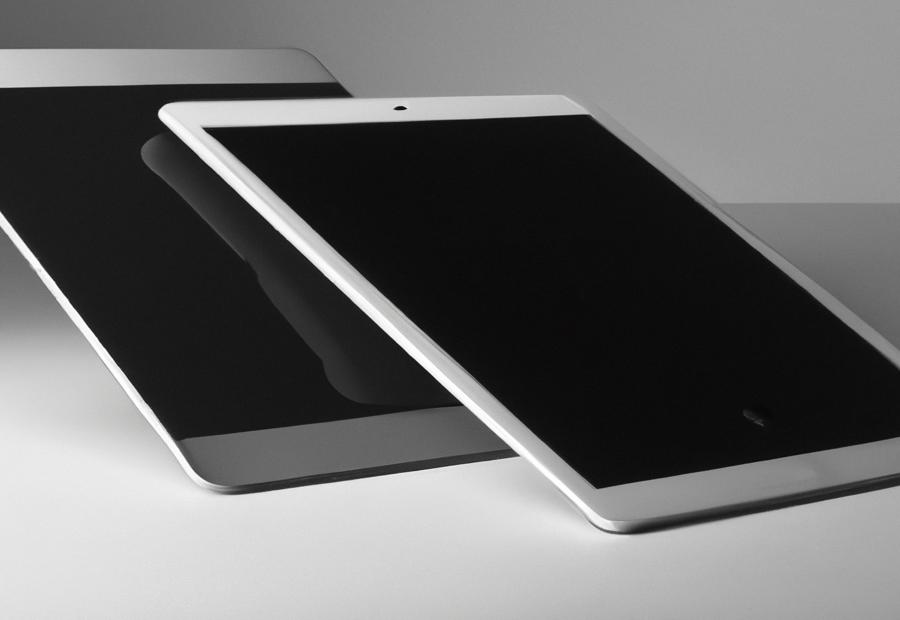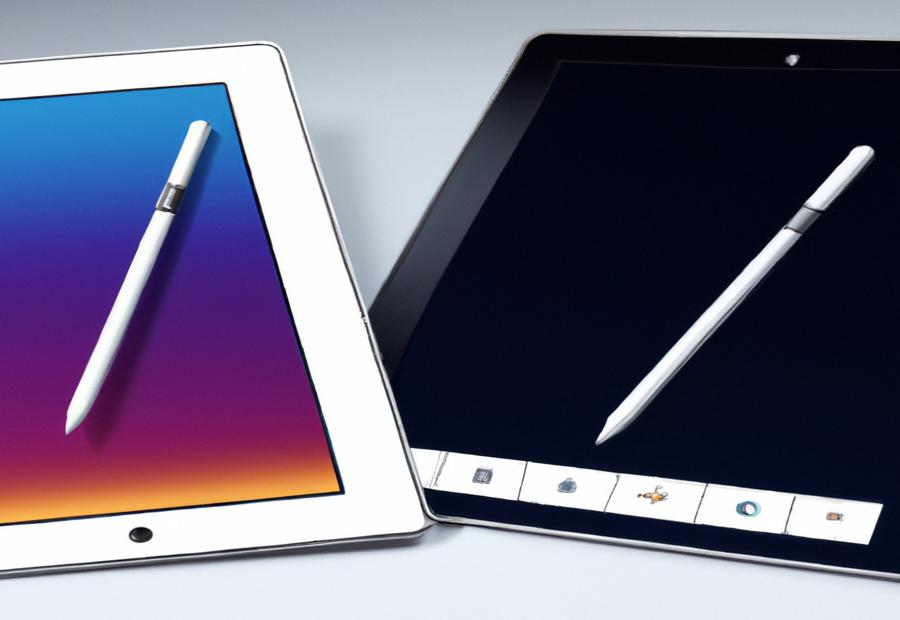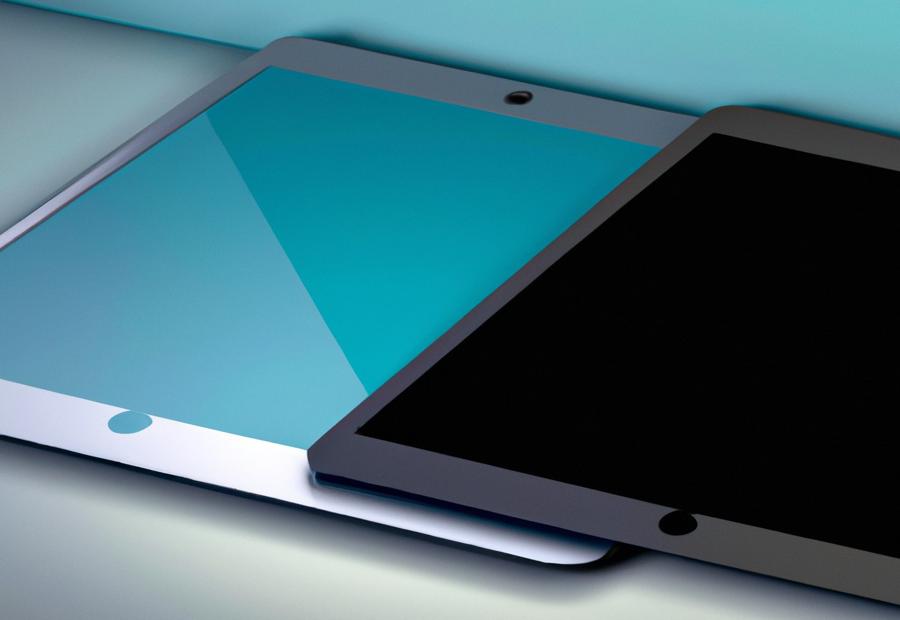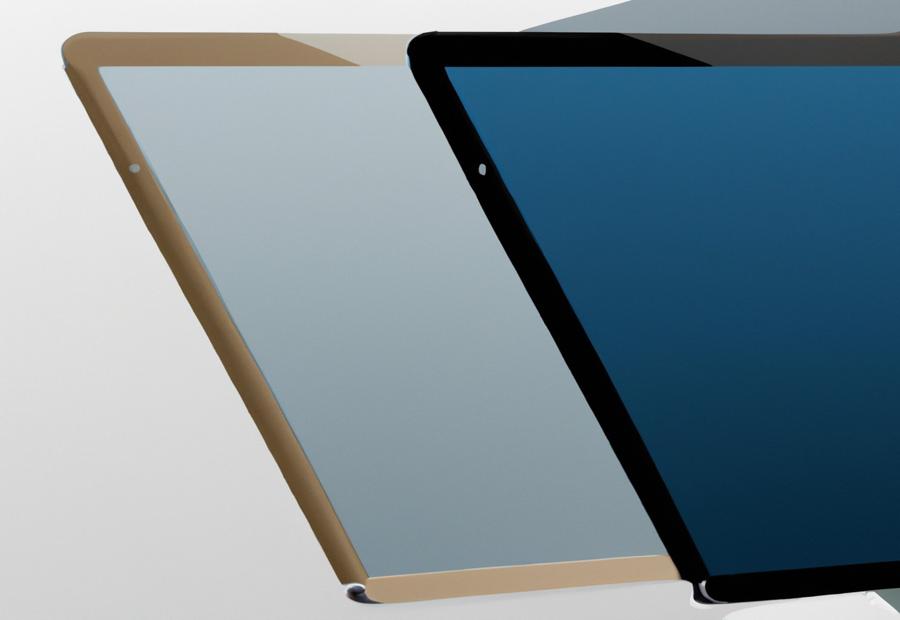Key Takeaway:
- Apple offers a wide range of iPad models with varying specifications, features, and sizes. It is important to consider your needs and preferences before making a purchase.
- The iPad lineup is divided into basic models and pro-level models. The newest iPad models released in 2022 include the iPad Air (5th gen), iPad Pro (6th gen), and iPad (10th gen). The iPad mini and iPad (10th gen) still use A-series processors, while the iPad Pro line has two sizes that are listed as different generations due to release dates.
- When comparing current iPad models, there are key differences to consider such as size and display. The screens vary depending on the model: the iPad Pro 12.9-inch screen is 12.9 inches, the iPad Pro 11-inch screen is 11 inches, the iPad Air and iPad (10th generation) screens are 10.86 inches, and the iPad mini screen is 8.3 inches. It is important to note that the actual viewable area is less than the stated size, and the Liquid Retina XDR display is only available on the 12.9-inch iPad Pro model. Other factors to consider include processor and storage options, camera and biometrics features, USB-C Thunderbolt/USB-4 connections and battery life, performance and graphics comparison, Wi-Fi connectivity options, storage capacity, and preinstalled apps.
Introduction to Comparing iPad Models

Photo Credits: Ipadmodels.Org by James Martin
Apple has many different iPad models for various user needs. These models differ in size, processing power, storage space, and cellular connectivity. To pick the right iPad, you need to understand all the features of each model and decide which one fits your needs.
You should think about many factors. Screen sizes range from 7.9 to 12.9 inches, with 10.2 inches being the most popular. iPads come in two storage sizes: 64GB or 256GB. Some models also have expandable storage through external drives. The processing strength varies from A12 Bionic to A14 Bionic, with A14 being the strongest. Plus, some models have cellular connectivity, providing internet access without Wi-Fi.
Some iPad models feature unique characteristics for special tasks. For example, iPad Pro models have the Apple Pencil, while iPad Airs have Touch ID for extra security. The iPad Mini is compact and great for travelling. Knowing these features and their advantages can help you choose the perfect iPad for your requirements.
iPad Lineup: Pro Level and Basic models

Photo Credits: Ipadmodels.Org by Adam Harris
The iPad collection has multiple models. Some are basic, others are pro-level. This caters to many user needs. The basic models are cost-effective and perfect for daily use. The pro-level models offer advanced features and top performance.
To make it easier to pick the right iPad model, a comparison table was made. It includes facts such as screen size, storage, camera quality, processor type, and price.
The pro-level models offer cool features like Face ID, Apple Pencil support, True Tone display, and high-performance processors. This makes them great for power users and pros. The basic models are budget-friendly and are great for students, children, and casual users. All iPads have unique benefits and features, so there’s something for everyone.
Comparison of current iPad models supported by Apple

Photo Credits: Ipadmodels.Org by Ryan Moore
Apple’s current lineup of iPads offers a diverse range of options for potential buyers. From the entry-level iPads to the high-end iPad Pro, each model has its unique strengths and weaknesses. In this comparison section, we will explore the differences between the various iPad models in terms of their size and display, processor and storage options, camera and biometrics features, connectivity options, and battery life, as well as performance and graphics.
Size and Display
Apple’s iPad models come in varied sizes and display features. Size and display affect user experience. Current iPad models offer a range of screen sizes from 7.9 inches (iPad Mini) to 12.9 inches (iPad Pro). Resolution varies by model, usually from 2048×1536 pixels for standard iPads to 2732×2048 pixels for iPad Pro. Display panel tech like True Tone, ProMotion, and P3 wide color gamut enhance colors and provide great visibility. Ideal iPad models cater to users’ requirements, from entertainment to content creation. Some models come with anti-reflective coatings, reducing glare and making it convenient for extended usage. It is important to consider size and display when choosing an iPad model. Also, get more storage; you never know when you’ll need it!
Processor and Storage options
The iPad range has various specs, such as different processors and storage options. Each model has its own features, as seen in the following table.
| Model | Processor | Storage |
|---|---|---|
| iPad | A12 Bionic chip with 64-bit architecture | 32GB or 128GB |
| iPad mini | A12 Bionic chip with Neural Engine | 64GB or 256GB |
| iPad Air | A14 Bionic chip with Neural Engine | 64GB or 256GB |
| iPad Pro | M1 chip with Neural Engine | 128GB, 256GB, 512GB, or 1TB |
The iPad, iPad mini, and iPad Air are all good for simple tasks like web browsing, email, social media, and document editing. They have a straightforward design, great battery life, and are cost-effective for novice users who need a handy device for productivity. The new models have comparing iPad models, which offer superior performance compared to the past models.
On the flip side, the high-end iPad Pro is equipped with the M1 chip, which is also used in the MacBook/Mac lineup. This makes it one of the most able tablets on the market, with strong processing power. It also has huge storage space (up to 2TB), allowing users to store lots of apps and HD videos without worrying about space.
The iPad Pro’s advanced features may be too much for basic productivity tasks. But pro multimedia professionals will appreciate all that they can do with this powerful tablet. The iPad Pro is more valuable than many laptops, as it has features like multi-tasking, long battery life, effective storage, camera, and biometric security functions. No matter if you want to use it for work or pleasure, this versatile device can easily become part of your daily life.
Camera and Biometrics features
The iPad models boast impressive camera and biometric features, elevating the user’s experience. The basic iPad (8th Gen) and iPad Air come with a 12 MP rear camera. The iPad Pro line has a 12 MP ultra-wide lens with LiDAR scanner, for enhanced AR experiences. All iPads feature a 7 MP front camera, except for the current iPad Pro models with the TrueDepth front-facing camera system and Face ID biometric authentication. Image stabilization capabilities, like cinematic video stabilization, automatic subject tracking, and extended dynamic range, also help create high-quality photos. For more information, check out this comprehensive comparison of iPad models.
For easy authentication, some devices have Touch ID, secured in the Home Button or on top buttons. Certain models support Apple Pencil technology, for annotation or drawings, and magnets for pairing and attaching Apple Magic Keyboard systems with backlit keys and trackpad. This further enhances the user’s typing experience and offers device protection.
Lastly, iPad models offer many biometric options. The Force Touch technology, from the Apple Watch, senses how hard you press against the display, giving action-shortcuts. The Dynamic Keyboard, present in specific models, enables swipe gestures for quick and comfortable keyboard navigation. For a detailed comparison of iPad models, check out this comprehensive chart.
USB-C Thunderbolt/USB-4 connections and Battery life
The latest iPad models provide USB-C Thunderbolt/USB-4 connections and various battery lives. With these options, fast charging and high-speed data transfer rates are possible. A convenient table compares the USB-C Thunderbolt/USB-4 connections, ports, and battery life of the latest iPad models.
For example, the iPad Pro 12.9-inch (5th Gen.) and the iPad Pro 11-inch (3rd Gen.) support Thunderbolt/USB-4 connections with 1x Thunderbolt/USB-4 port. They also have DisplayPort and charging support on all three ports. Plus, they offer up to 10 hours of battery life, with an extra two hours compared to their predecessors. The iPad Pro 11-inch (3rd Gen.) also has a Magic Keyboard Attachment for wireless charging.
On the other hand, the iPad Air (4th Gen.) and the iPad (8th Gen.) models have USB-C standard connections. The iPad Air (4th Gen.) has 1x USB-C port with DisplayPort and USB 3.2 Gen 1. Whereas, the iPad (8th Gen.) has no Thunderbolt support but includes a Lightning port and USB-A port. Both these models have up to 10 hours of battery life.
All the latest iPad models support fast alternative wireless charging options like magnetic wireless charging controlled via Magic Keyboard Attachment or Apple Pencil. Furthermore, Fast Charge up to fifty percent charge in half an hour is available. The latest iPad Pro models also have additional drivers for unified memory architecture which boosts system performance.
Apple has invested heavily in its current iPad range, transforming them from content-consumption devices to desktop computer-level power and efficacy. As technology advances, these devices are designed to give consumers optimum utility. So get set for some serious speed and smooth multitasking with the high-performance processors and graphics of the latest iPad models.
Performance and Graphics comparison
Are you shopping for an iPad? It’s essential to think about performance and graphics. Performance relies on the processor and RAM, and graphics depend on the display tech and resolution. To compare iPad models, look at this specs table:
| Model | Processor | RAM | Display Technology | Resolution |
|---|---|---|---|---|
| iPad (8th Gen) | A12 Bionic chip with Neural Engine | 3GB | Retina Display with LED-backlit Multi-Touch display with IPS technology | 2160 x 1620 pixels |
| iPad Air (4th Gen) | A14 Bionic chip with Neural Engine | 3GB | Retina Display with True Tone and P3 wide color gamut | 2360 x 1640 pixels |
Also, note that the number of cores in processors can differ between models. For example, the iPad Pro 11-inch has an eight-core GPU, but some other models only have four. To learn more about comparing iPad models, check out this comprehensive guide.
It’s incredible how much iPads have developed in terms of performance and graphics since their release. Apple is dedicated to increasing the processing power and graphic capabilities of their tablets. Therefore, newer iPad models provide noticeably better performance and graphics than previous ones. Keep this in mind when buying!
Wi-Fi connectivity options

Photo Credits: Ipadmodels.Org by Edward Campbell
With numerous models of iPads available in the market, choosing the right one can be a challenge. This section will focus on the Wi-Fi connectivity options of various iPad models, including their Wi-Fi speed and frequency bands. We will also evaluate their support for Wi-Fi 6E, a technology that has gained popularity in recent times due to its faster speeds, lower latency, and increased capacity.
Wi-Fi speed and frequency bands
The iPad models vary in Wi-Fi speed and frequency bands. Every tablet has Wi-Fi 6 (802.11ax). This delivers speedy data transfer over Wi-Fi networks.
A reference data table shows the Wi-Fi speed and frequency bands for each iPad model. This includes: 12.9-inch iPad Pro (5th gen.), 11-inch iPad Pro (3rd gen.), iPad Air (4th gen.), iPad (8th gen.), and iPad mini (5th gen.). High-end iPad Pro models have more frequency bands than the basic lineup.
Moreover, the latest iPads have Wi-Fi 6E tech. This allows faster connection speeds at shorter distances. So, new iPad models offer faster internet speeds due to their advanced Wi-Fi capabilities. With Wi-Fi 6E on an iPad, users can enjoy lightning-fast internet speeds. (Note: Apple.com/reference)
Wi-Fi 6E support
Apple’s latest iPad models come with Wi-Fi 6E support. Making them the speediest wireless devices around! This feature lets users enjoy a smoother experience with faster internet speeds and consistent connectivity.
Wi-Fi 6E lets iPads connect to networks that use the new 6GHz frequency band, as well as the existing 2.4GHz and 5GHz bands. This gives more bandwidth, and reduces interference for better performance.
Plus, these iPad models have enhanced security features to prevent unauthorized users from accessing the network. And, when connected to these networks, users benefit from improved battery performance.
Overall, the inclusion of Wi-Fi 6E makes the latest iPads even more powerful and efficient. It offers faster internet and improved security for an ideal user experience.
Storage Capacity of iPad and preinstalled apps

Photo Credits: Ipadmodels.Org by William Martin
The Apple iPad is a common device that offers users several storage options. The amount of storage depends on the model of iPad purchased. Keep in mind, that preinstalled apps take up a portion of space.
To find the storage capacity of different iPad models, look at this table:
| Model | Storage Options | Preinstalled Apps Space |
|---|---|---|
| iPad Pro | 128GB, 256GB, 512GB, 1TB, 2TB | Up to 10.49GB |
| iPad Air | 64GB, 256GB | Up to 5.2GB |
| iPad | 32GB, 128GB | Up to 4.62GB |
| iPad Mini | 64GB, 256GB | Up to 5.07GB |
This table gives us a good understanding of the available storage options and the space preinstalled apps use.
If users need extra space, they can delete preinstalled apps or buy an iCloud storage plan to store files and media securely.
CNET reports suggest that preinstalled apps on iPads have become smaller in size over time. For example, the iPad Pro 2020 has preinstalled apps that take up 2.51GB less space than the previous model. This is great news as it means users can store more on their device.
Conclusion: Summary of key differences between iPad models

Photo Credits: Ipadmodels.Org by Dennis Lopez
iPads come in many models. It’s important to know their specs and features to make an informed choice. A comparison table is good for seeing their differences. For example, screen size, weight, processor, and storage capacity. Each one has unique qualities too, like the iPad Pro’s good cameras and high refresh rate. And the iPad Mini is more portable with a small screen. Choose a model that fits your needs. The latest models sell fast, so don’t miss out on upgrading your digital experience.
Five Facts About Comparing iPad Models:
- ✅ Apple’s iPad lineup is divided into Pro level and basic models. (Source: Lifewire)
- ✅ The newest iPad models released in 2022 include iPad Air (5th gen), iPad Pro (6th gen), and iPad (10th gen). (Source: Lifewire)
- ✅ The Liquid Retina XDR display is only available on the 12.9-inch iPad Pro model. (Source: T-Mobile, Lifewire, and Maple Store)
- ✅ The iPad Pro is the most capable and impressive iPad lineup to date, with faster download speeds, 15% faster performance, and up to 35% faster graphics performance than previous models. (Source: ZDNet)
- ✅ Available space on an iPad may vary based on model, settings, and software version. (Source: JB Hi-Fi)
FAQs about Comparing Ipad Models
What are the different sizes and screen dimensions of Apple’s iPad models?
Apple’s iPad models range from the 8.3-inch iPad mini to the 12.9-inch iPad Pro, with screen sizes measuring diagonally as rectangles. The iPad Pro 12.9-inch screen is 12.9 inches, the iPad Pro 11-inch screen is 11 inches, the iPad Air and iPad (10th generation) screens are 10.86 inches, and the iPad mini screen is 8.3 inches. However, the actual viewable area is less than the stated size due to rounded corners.
What is the Liquid Retina XDR display and on which iPad model is it available?
The Liquid Retina XDR display is a high-end screen technology that offers bright, sharp, and accurate pictures. It is only available on the 12.9-inch iPad Pro model, which includes a 12.9-inch Liquid Retina XDR or 11-inch Liquid Retina display with ProMotion and True Tone.
What are the differences between the iPad Pro 6th generation and previous models?
The iPad Pro 6th generation, released in 2022, features the Apple Silicon M2 processor with 20 billion transistors, which is 25% more than the M1 processor. It also has faster download speeds, 15% faster performance, and up to 35% faster graphics performance than previous models. Additionally, it has up to 2TB of storage capacity, Face ID for biometrics, and an improved camera system with a 12MP wide, 10MP ultrawide rear, and 12MP TrueDepth FaceTime front camera. The iPad Pro is equipped with USB-C Thunderbolt/USB-4 connections, weighs 1.03 pounds for the 11-inch model and 1.5 pounds for the 12.9-inch model, is available in silver or space gray, has a battery life of 10 hours, and can handle a large workload with up to eight apps open and in use simultaneously.
What are the Wi-Fi connectivity options for iPad models?
The devices have different types of Wi-Fi connectivity, including Wi-Fi 6E, Wi-Fi 6, and Wi-Fi with speeds ranging from 866 Mbps to 2.4 Gbps. The Wi-Fi connectivity is available on both 2.4GHz and 5GHz frequency bands, and some devices support simultaneous dual-band connectivity. Additionally, some models support Wi-Fi 6E, which is a newer and faster version of Wi-Fi 6. Cellular and wireless connectivity are also available on the devices.
How much capacity and available space do iPad models have?
The available space on iPad models varies due to many factors. The standard configuration uses 10-13GB of space, depending on the model and settings. Preinstalled apps take up about 4GB of space, but they can be deleted and restored. Storage capacity may change based on software version and may vary by device.
Why is it easy to choose an iPad from Apple’s current lineup?
Apple’s iPad lineup is divided into two levels: Pro and basic models. The newest iPads released in 2022 include the iPad Air (5th gen), iPad Pro (6th gen), and iPad (10th gen). The devices have different features such as screen size, storage options, and processor performance. A comparison chart is available to help customers compare current iPad models supported by Apple to make an informed decision.